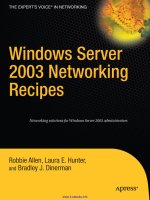Apress-Visual CSharp 2010 Recipes A Problem Solution Approach_6 doc
Bạn đang xem bản rút gọn của tài liệu. Xem và tải ngay bản đầy đủ của tài liệu tại đây (1.89 MB, 95 trang )
CHAPTER 13 ■ COMMONLY USED INTERFACES AND PATTERNS
640
13-5. Implement an Enumerable Type Using a Custom
Iterator
Problem
You need to create an enumerable type but do not want to rely on the built-in iterator support provided
by the .NET Framework (described in recipe 13-4).
Solution
Implement the interface System.Collections.IEnumerable on your collection type. The GetEnumerator
method of the IEnumerable interface returns an enumerator, which is an object that implements the
interface System.Collections.IEnumerator. The IEnumerator interface defines the methods used by the
foreach statement to enumerate the collection.
Implement a private inner class within the enumerable type that implements the interface
IEnumerator and can iterate over the enumerable type while maintaining appropriate state information.
In the GetEnumerator method of the enumerable type, create and return an instance of the iterator class.
How It Works
The automatic iterator support built into C# is very powerful and will be sufficient in the majority of
cases. However, in some cases you may want to take direct control of the implementation of your
collection’s iterators. For example, you may want an iterator that supports changes to the underlying
collection during enumeration.
Whatever your reason, the basic model of an enumerable collection is the same as that described in
recipe 13-4. Your enumerable type should implement the IEnumerable interface, which requires you to
implement a method named GetEnumerator. However, instead of using the yield return statement in
GetEnumerator, you must instantiate and return an object that implements the IEnumerator interface.
The IEnumerator interface provides a read-only, forward-only cursor for accessing the members of the
underlying collection. Table 13-2 describes the members of the IEnumerator interface. The IEnumerator
instance returned by GetEnumerator is your custom iterator—the object that actually supports
enumeration of the collection’s data elements.
CHAPTER 13 ■ COMMONLY USED INTERFACES AND PATTERNS
641
Table 13-2. Members of the IEnumerator Interface
Member Description
Current
Property that returns the current data element. When the enumerator is created, Current
refers to a position preceding the first data element. This means you must call MoveNext
before using Current. If Current is called and the enumerator is positioned before the first
element or after the last element in the data collection, Current must throw a
System.InvalidOperationException.
MoveNext
Method that moves the enumerator to the next data element in the collection. Returns true if
there are more elements; otherwise, it returns false. If the underlying source of data changes
during the life of the enumerator, MoveNext must throw an InvalidOperationException.
Reset
Method that moves the enumerator to a position preceding the first element in the data
collection. If the underlying source of data changes during the life of the enumerator, Reset
must throw an InvalidOperationException.
If your collection class contains different types of data that you want to enumerate separately,
implementing the IEnumerable interface on the collection class is insufficient. In this case, you would
implement a number of properties that return different IEnumerator instances.
The Code
The TeamMember, Team, and TeamMemberEnumerator classes in the following example demonstrate the
implementation of a custom iterator using the IEnumerable and IEnumerator interfaces. The TeamMember
class represents a member of a team. The Team class, which represents a team of people, is a collection of
TeamMember objects. Team implements the IEnumerable interface and declares a separate class, named
TeamMemberEnumerator, to provide enumeration functionality. Team implements the Observer pattern
using delegate and event members to notify all TeamMemberEnumerator objects if their underlying Team
changes. (See recipe 13-11 for a detailed description of the Observer pattern.) The TeamMemberEnumerator
class is a private nested class, so you cannot create instances of it other than through the
Team.GetEnumerator method.
using System;
using System.Collections;
namespace Apress.VisualCSharpRecipes.Chapter13
{
// TeamMember class represents an individual team member.
public class TeamMember
{
public string Name;
public string Title;
CHAPTER 13 ■ COMMONLY USED INTERFACES AND PATTERNS
642
// Simple TeamMember constructor.
public TeamMember(string name, string title)
{
Name = name;
Title = title;
}
// Returns a string representation of the TeamMember.
public override string ToString()
{
return string.Format("{0} ({1})", Name, Title);
}
}
// Team class represents a collection of TeamMember objects. Implements
// the IEnumerable interface to support enumerating TeamMember objects.
public class Team : IEnumerable
{
// TeamMemberEnumerator is a private nested class that provides
// the functionality to enumerate the TeamMembers contained in
// a Team collection. As a nested class, TeamMemberEnumerator
// has access to the private members of the Team class.
private class TeamMemberEnumerator : IEnumerator
{
// The Team that this object is enumerating.
private Team sourceTeam;
// Boolean to indicate whether underlying Team has changed
// and so is invalid for further enumeration.
private bool teamInvalid = false;
// Integer to identify the current TeamMember. Provides
// the index of the TeamMember in the underlying ArrayList
// used by the Team collection. Initialize to -1, which is
// the index prior to the first element.
private int currentMember = -1;
// Constructor takes a reference to the Team that is the source
// of enumerated data.
internal TeamMemberEnumerator(Team team)
{
this.sourceTeam = team;
// Register with sourceTeam for change notifications.
sourceTeam.TeamChange +=
new TeamChangedEventHandler(this.TeamChange);
}
CHAPTER 13 ■ COMMONLY USED INTERFACES AND PATTERNS
643
// Implement the IEnumerator.Current property.
public object Current
{
get
{
// If the TeamMemberEnumerator is positioned before
// the first element or after the last element, then
// throw an exception.
if (currentMember == -1 ||
currentMember > (sourceTeam.teamMembers.Count - 1))
{
throw new InvalidOperationException();
}
//Otherwise, return the current TeamMember.
return sourceTeam.teamMembers[currentMember];
}
}
// Implement the IEnumerator.MoveNext method.
public bool MoveNext()
{
// If underlying Team is invalid, throw exception.
if (teamInvalid)
{
throw new InvalidOperationException("Team modified");
}
// Otherwise, progress to the next TeamMember.
currentMember++;
// Return false if we have moved past the last TeamMember.
if (currentMember > (sourceTeam.teamMembers.Count - 1))
{
return false;
}
else
{
return true;
}
}
// Implement the IEnumerator.Reset method.
// This method resets the position of the TeamMemberEnumerator
// to the beginning of the TeamMembers collection.
public void Reset()
{
CHAPTER 13 ■ COMMONLY USED INTERFACES AND PATTERNS
644
// If underlying Team is invalid, throw exception.
if (teamInvalid)
{
throw new InvalidOperationException("Team modified");
}
// Move the currentMember pointer back to the index
// preceding the first element.
currentMember = -1;
}
// An event handler to handle notifications that the underlying
// Team collection has changed.
internal void TeamChange(Team t, EventArgs e)
{
// Signal that the underlying Team is now invalid.
teamInvalid = true;
}
}
// A delegate that specifies the signature that all team change event
// handler methods must implement.
public delegate void TeamChangedEventHandler(Team t, EventArgs e);
// An ArrayList to contain the TeamMember objects.
private ArrayList teamMembers;
// The event used to notify TeamMemberEnumerators that the Team
// has changed.
public event TeamChangedEventHandler TeamChange;
// Team constructor.
public Team()
{
teamMembers = new ArrayList();
}
// Implement the IEnumerable.GetEnumerator method.
public IEnumerator GetEnumerator()
{
return new TeamMemberEnumerator(this);
}
// Adds a TeamMember object to the Team.
public void AddMember(TeamMember member)
{
teamMembers.Add(member);
CHAPTER 13 ■ COMMONLY USED INTERFACES AND PATTERNS
645
// Notify listeners that the list has changed.
if (TeamChange != null)
{
TeamChange(this, null);
}
}
}
// A class to demonstrate the use of Team.
public class Recipe13_05
{
public static void Main()
{
// Create a new Team.
Team team = new Team();
team.AddMember(new TeamMember("Curly", "Clown"));
team.AddMember(new TeamMember("Nick", "Knife Thrower"));
team.AddMember(new TeamMember("Nancy", "Strong Man"));
// Enumerate the Team.
Console.Clear();
Console.WriteLine("Enumerate with foreach loop:");
foreach (TeamMember member in team)
{
Console.WriteLine(member.ToString());
}
// Enumerate using a While loop.
Console.WriteLine(Environment.NewLine);
Console.WriteLine("Enumerate with while loop:");
IEnumerator e = team.GetEnumerator();
while (e.MoveNext())
{
Console.WriteLine(e.Current);
}
// Enumerate the Team and try to add a Team Member.
// (This will cause an exception to be thrown.)
Console.WriteLine(Environment.NewLine);
Console.WriteLine("Modify while enumerating:");
foreach (TeamMember member in team)
{
Console.WriteLine(member.ToString());
team.AddMember(new TeamMember("Stumpy", "Lion Tamer"));
}
CHAPTER 13 ■ COMMONLY USED INTERFACES AND PATTERNS
646
// Wait to continue.
Console.WriteLine(Environment.NewLine);
Console.WriteLine("Main method complete. Press Enter");
Console.ReadLine();
}
}
}
The example enumerates through the data with foreach and while loops and then attempts to
modify the data during an enumeration, resulting in an exception. The output from the example is as
follows:
Enumerate with foreach loop:
Curly (Clown)
Nick (Knife Thrower)
Nancy (Strong Man)
Enumerate with while loop:
Curly (Clown)
Nick (Knife Thrower)
Nancy (Strong Man)
Modify while enumerating:
Curly (Clown)
CHAPTER 13 ■ COMMONLY USED INTERFACES AND PATTERNS
647
Unhandled Exception: System.InvalidOperationException: Team modified
at Apress.VisualCSharpRecipes.Chapter13.Team.TeamMemberEnumerator.MoveNext() in
C:\Users\Adam\Documents\Work\C# Cookbook\Repository\CSHARPRECIPES\SourceCode
\Chapter13\Recipe13-05\Recipe13-05.cs:line 85
at Apress.VisualCSharpRecipes.Chapter13.Recipe13_05.Main() in C:\Users\Adam\
Documents\Work\C# Cookbook\Repository\CSH
ARPRECIPES\SourceCode\Chapter13\Recipe13-05\Recipe13-05.cs:line 195
Press any key to continue . . .
13-6. Implement a Disposable Class
Problem
You need to create a class that references unmanaged resources and provide a mechanism for users of
the class to free those unmanaged resources deterministically.
Solution
Implement the System.IDisposable interface and release the unmanaged resources when client code
calls the IDisposable.Dispose method.
How It Works
An unreferenced object continues to exist on the managed heap and consume resources until the
garbage collector releases the object and reclaims the resources. The garbage collector will automatically
free managed resources (such as memory), but it will not free unmanaged resources (such as file handles
and database connections) referenced by managed objects. If an object contains data members that
reference unmanaged resources, the object must free those resources explicitly.
One solution is to declare a destructor—or finalizer—for the class (destructor is a C++ term
equivalent to the more general .NET term finalizer). Prior to reclaiming the memory consumed by an
instance of the class, the garbage collector calls the object’s finalizer. The finalizer can take the necessary
steps to release any unmanaged resources. Unfortunately, because the garbage collector uses a single
thread to execute all finalizers, use of finalizers can have a detrimental effect on the efficiency of the
garbage collection process, which will affect the performance of your application. In addition, you
cannot control when the runtime frees unmanaged resources because you cannot call an object’s
finalizer directly, and you have only limited control over the activities of the garbage collector using the
System.GC class.
CHAPTER 13 ■ COMMONLY USED INTERFACES AND PATTERNS
648
As a complementary mechanism to using finalizers, the .NET Framework defines the Dispose
pattern as a means to provide deterministic control over when to free unmanaged resources. To
implement the Dispose pattern, a class must implement the IDisposable interface, which declares a
single method named Dispose. In the Dispose method, you must implement the code necessary to
release any unmanaged resources and remove the object from the list of objects eligible for finalization if
a finalizer has been defined.
Instances of classes that implement the Dispose pattern are called disposable objects. When code
has finished with a disposable object, it calls the object’s Dispose method to free all resources and make
it unusable, but still relies on the garbage collector to eventually release the object memory. It’s
important to understand that the runtime does not enforce disposal of objects; it’s the responsibility of
the client to call the Dispose method. However, because the .NET Framework class library uses the
Dispose pattern extensively, C# provides the using statement to simplify the correct use of disposable
objects. The following code shows the structure of a using statement:
using (FileStream fileStream = new FileStream("SomeFile.txt", FileMode.Open)) {
// Do something with the fileStream object.
}
When the code reaches the end of the block in which the disposable object was declared, the
object’s Dispose method is automatically called, even if an exception is raised. Here are some points to
consider when implementing the Dispose pattern:
• Client code should be able to call the Dispose method repeatedly with no adverse
effects.
• In multithreaded applications, it’s important that only one thread execute the
Dispose method at a time. It’s normally the responsibility of the client code to
ensure thread synchronization, although you could decide to implement
synchronization within the Dispose method.
• The Dispose method should not throw exceptions.
• Because the Dispose method does all necessary cleaning up, you do not need to
call the object’s finalizer. Your Dispose method should call the
GC.SuppressFinalize method to ensure that the finalizer is not called during
garbage collection.
• Implement a finalizer that calls the unmanaged cleanup part of your Dispose
method as a safety mechanism in case client code does not call Dispose correctly.
However, avoid referencing managed objects in finalizers, because you cannot be
certain of the object’s state.
• If a disposable class extends another disposable class, the Dispose method of the
child must call the Dispose method of its base class. Wrap the child’s code in a try
block and call the parent’s Dispose met
hod in a finally clause to ensure
execution.
• Other instance methods and properties of the class should throw a
System.ObjectDisposedException exception if client code attempts to execute a
method on an already disposed object.
CHAPTER 13 ■ COMMONLY USED INTERFACES AND PATTERNS
649
The Code
The following example demonstrates a common implementation of the Dispose pattern.
using System;
namespace Apress.VisualCSharpRecipes.Chapter13
{
// Implement the IDisposable interface.
public class DisposeExample : IDisposable
{
// Private data member to signal if the object has already been
// disposed.
bool isDisposed = false;
// Private data member that holds the handle to an unmanaged resource.
private IntPtr resourceHandle;
// Constructor.
public DisposeExample()
{
// Constructor code obtains reference to unmanaged resource.
resourceHandle = default(IntPtr);
}
// Destructor/finalizer. Because Dispose calls GC.SuppressFinalize,
// this method is called by the garbage collection process only if
// the consumer of the object does not call Dispose as it should.
~DisposeExample()
{
// Call the Dispose method as opposed to duplicating the code to
// clean up any unmanaged resources. Use the protected Dispose
// overload and pass a value of "false" to indicate that Dispose is
// being called during the garbage collection process, not by
// consumer code.
Dispose(false);
}
// Public implementation of the IDisposable.Dispose method, called
// by the consumer of the object in order to free unmanaged resources
// deterministically.
public void Dispose()
{
// Call the protected Dispose overload and pass a value of "true"
// to indicate that Dispose is being called by consumer code, not
// by the garbage collector.
Dispose(true);
// Because the Dispose method performs all necessary cleanup,
// ensure the garbage collector does not call the class destructor.
GC.SuppressFinalize(this);
}
CHAPTER 13 ■ COMMONLY USED INTERFACES AND PATTERNS
650
// Protected overload of the Dispose method. The disposing argument
// signals whether the method is called by consumer code (true), or by
// the garbage collector (false). Note that this method is not part of
// the IDisposable interface because it has a different signature to the
// parameterless Dispose method.
protected virtual void Dispose(bool disposing)
{
// Don't try to dispose of the object twice.
if (!isDisposed)
{
// Determine if consumer code or the garbage collector is
// calling. Avoid referencing other managed objects during
// finalization.
if (disposing)
{
// Method called by consumer code. Call the Dispose method
// of any managed data members that implement the
// IDisposable interface.
//
}
// Whether called by consumer code or the garbage collector,
// free all unmanaged resources and set the value of managed
// data members to null.
// Close(resourceHandle);
// In the case of an inherited type, call base.Dispose(disposing).
}
// Signal that this object has been disposed.
isDisposed = true;
}
// Before executing any functionality, ensure that Dispose has not
// already been executed on the object.
public void SomeMethod()
{
// Throw an exception if the object has already been disposed.
if (isDisposed)
{
throw new ObjectDisposedException("DisposeExample");
}
// Execute method functionality.
// . . .
}
}
// A class to demonstrate the use of DisposeExample.
public class Recipe13_06
{
CHAPTER 13 ■ COMMONLY USED INTERFACES AND PATTERNS
651
public static void Main()
{
// The using statement ensures the Dispose method is called
// even if an exception occurs.
using (DisposeExample d = new DisposeExample())
{
// Do something with d.
}
// Wait to continue.
Console.WriteLine(Environment.NewLine);
Console.WriteLine("Main method complete. Press Enter");
Console.ReadLine();
}
}
}
13-7. Implement a Formattable Type
Problem
You need to implement a type that can create different string representations of its content based on the
use of format specifiers, for use in formatted strings.
Solution
Implement the System.IFormattable interface.
How It Works
The following code fragment demonstrates the use of format specifiers in the WriteLine method of the
System.Console class. The format specifiers are inside the braces (shown in bold in the example).
double a = 345678.5678;
uint b = 12000;
byte c = 254;
Console.WriteLine("a = {0}, b = {1}, and c = {2}", a, b, c);
Console.WriteLine("a = {0:c0}, b = {1:n4}, and c = {2,10:x5}", a, b, c);
CHAPTER 13 ■ COMMONLY USED INTERFACES AND PATTERNS
652
When run on a machine configured with English (UK) regional settings, this code will result in the
output shown here:
a = 345678.5678, b = 12000, and c = 254
a = £345,679, b = 12,000.0000, and c = 000fe
As you can see, changing the contents of the format specifiers changes the format of the output
significantly, even though the data has not changed. To enable support for format specifiers in your own
types, you must implement the IFormattable interface. IFormattable declares a single method named
ToString with the following signature:
string ToString(string format, IFormatProvider formatProvider);
The format argument is a System.String containing a format string. The format string is the portion
of the format specifier that follows the colon. For example, in the format specifier {2,10:x5} used in the
previous example, x5 is the format string. The format string contains the instructions that the
IFormattable instance should use when it’s generating the string representation of its content. The .NET
Framework documentation for IFormattable states that types that implement IFormattable must
support the G (general) format string, but that the other supported format strings depend on the
implementation. The format argument will be null if the format specifier does not include a format
string component; for example, {0} or {1,20}.
The formatProvider argument is a reference to an instance of a type that implements
System.IFormatProvider, and that provides access to information about the cultural and regional
preferences to use when generating the string representation of the IFormattable object. This
information includes data such as the appropriate currency symbol or number of decimal places to use.
By default, formatProvider is null, which means you should use the current thread’s regional and
cultural settings, available through the static method CurrentCulture of the
System.Globalization.CultureInfo class. Some methods that generate formatted strings, such as
String.Format, allow you to specify an alternative IFormatProvider to use such as CultureInfo,
DateTimeFormatInfo, or NumberFormatInfo.
The .NET Framework uses IFormattable primarily to support the formatting of value types, but it
can be used to good effect with any type.
The Code
The following example contains a class named Person that implements the IFormattable interface. The
Person class contains the title and names of a person and will render the person’s name in different
formats depending on the format strings provided. The Person class does not make use of regional and
cultural settings provided by the formatProvider argument. The Main method demonstrates how to use
the formatting capabilities of the Person class.
using System;
namespace Apress.VisualCSharpRecipes.Chapter13
{
public class Person : IFormattable
{
CHAPTER 13 ■ COMMONLY USED INTERFACES AND PATTERNS
653
// Private members to hold the person's title and name details.
private string title;
private string[] names;
// Constructor used to set the person's title and names.
public Person(string title, params string[] names)
{
this.title = title;
this.names = names;
}
// Override the Object.ToString method to return the person's
// name using the general format.
public override string ToString()
{
return ToString("G", null);
}
// Implementation of the IFormattable.ToString method to return the
// person's name in different forms based on the format string
// provided.
public string ToString(string format, IFormatProvider formatProvider)
{
string result = null;
// Use the general format if none is specified.
if (format == null) format = "G";
// The contents of the format string determine the format of the
// name returned.
switch (format.ToUpper()[0])
{
case 'S':
// Use short form - first initial and surname.
result = names[0][0] + ". " + names[names.Length - 1];
break;
case 'P':
// Use polite form - title, initials, and surname.
// Add the person's title to the result.
if (title != null && title.Length != 0)
{
result = title + ". ";
}
// Add the person's initials and surname.
for (int count = 0; count < names.Length; count++)
{
if (count != (names.Length - 1))
{
result += names[count][0] + ". ";
}
CHAPTER 13 ■ COMMONLY USED INTERFACES AND PATTERNS
654
else
{
result += names[count];
}
}
break;
case 'I':
// Use informal form - first name only.
result = names[0];
break;
case 'G':
default:
// Use general/default form - first name and surname.
result = names[0] + " " + names[names.Length - 1];
break;
}
return result;
}
}
// A class to demonstrate the use of Person.
public class Recipe13_07
{
public static void Main()
{
// Create a Person object representing a man with the name
// Mr. Richard Glen David Peters.
Person person =
new Person("Mr", "Richard", "Glen", "David", "Peters");
// Display the person's name using a variety of format strings.
System.Console.WriteLine("Dear {0:G},", person);
System.Console.WriteLine("Dear {0:P},", person);
System.Console.WriteLine("Dear {0:I},", person);
System.Console.WriteLine("Dear {0},", person);
System.Console.WriteLine("Dear {0:S},", person);
// Wait to continue.
Console.WriteLine(Environment.NewLine);
Console.WriteLine("Main method complete. Press Enter");
Console.ReadLine();
}
}
}
CHAPTER 13 ■ COMMONLY USED INTERFACES AND PATTERNS
655
Usage
When executed, the preceding example produces the following output:
Dear Richard Peters,
Dear Mr. R. G. D. Peters,
Dear Richard,
Dear Richard Peters,
Dear R. Peters,
13-8. Implement a Custom Exception Class
Problem
You need to create a custom exception class so that you can use the runtime’s exception-handling
mechanism to handle application-specific exceptions.
Solution
Create a serializable class that extends the System.Exception class. Add support for any custom data
members required by the exception, including constructors and properties required to manipulate the
data members.
How It Works
Exception classes are unique in the fact that you do not declare new classes solely to implement new or
extended functionality. The runtime’s exception-handling mechanism—exposed by the C# statements
try, catch, and finally—works based on the type of exception thrown, not the functional or data
members implemented by the thrown exception.
If you need to throw an exception, you should use an existing exception class from the .NET
Framework class library, if a suitable one exists. For example, some useful exceptions include the
following:
• System.ArgumentNullException, when code passes a null argument value that
does not support null arguments to your method
• System.ArgumentOutOfRangeException, when code passes an inappropriately large
or small argument value to your method
CHAPTER 13 ■ COMMONLY USED INTERFACES AND PATTERNS
656
• System.FormatException, when code attempts to pass your method a String
argument containing incorrectly formatted data
If none of the existing exception classes meet your needs, or you feel your application would benefit
from using application-specific exceptions, it’s a simple matter to create your own exception class. In
order to integrate your custom exception with the runtime’s exception-handling mechanism and remain
consistent with the pattern implemented by .NET Framework–defined exception classes, you should do
the following:
• Give your exception class a meaningful name ending in the word Exception, such
as TypeMismatchException or RecordNotFoundException.
• Mark your exception class as sealed if you do not intend other exception classes to
extend it.
• Implement additional data members and properties to support custom
information that the exception class should provide.
• Implement three public constructors with the signatures shown here and ensure
that they call the base class constructor:
public CustomException() : base() {}
public CustomException(string msg): base(msg) {}
public CustomException(string msg, Exception inner) : base(msg, inner) {}
• Make your exception class serializable so that the runtime can marshal instances
of your exception across application domain and machine boundaries. Applying
the attribute System.SerializableAttribute is sufficient for exception classes that
do not implement custom data members. However, because Exception
implements the interface System.Runtime.Serialization.ISerializable, if your
exception declares custom data members, you must override the
ISerializable.GetObjectData method of the Exception class as well as implement
a deserialization constructor with this signature. If your exception class is sealed,
mark the deserialization constructor as private; otherwise, mark it as protected.
The GetObjectData method and deserialization constructor must call the
equivalent base class method to allow the base class to serialize and deserialize its
data correctly. (See recipe 13-1 for details on making classes serializable.)
■ Tip In large applications, you will usually implement quite a few custom exception classes. It pays to put
significant thought into how you organize your custom exceptions and how code will use them. Generally, avoid
creating new exception classes unless code will make specific efforts to catch that exception; use data members
to achieve informational granularity, not additional exception classes. In addition, avoid deep class hierarchies
when possible in favor of broad, shallow hierarchies.
CHAPTER 13 ■ COMMONLY USED INTERFACES AND PATTERNS
657
The Code
The following example is a custom exception named CustomException that extends Exception and
declares two custom data members: a string named stringInfo and a bool named booleanInfo.
using System;
using System.Runtime.Serialization;
namespace Apress.VisualCSharpRecipes.Chapter13
{
// Mark CustomException as Serializable.
[Serializable]
public sealed class CustomException : Exception
{
// Custom data members for CustomException.
private string stringInfo;
private bool booleanInfo;
// Three standard constructors and simply call the base class.
// constructor (System.Exception).
public CustomException() : base() { }
public CustomException(string message) : base(message) { }
public CustomException(string message, Exception inner)
: base(message, inner) { }
// The deserialization constructor required by the ISerialization
// interface. Because CustomException is sealed, this constructor
// is private. If CustomException were not sealed, this constructor
// should be declared as protected so that derived classes can call
// it during deserialization.
private CustomException(SerializationInfo info,
StreamingContext context) : base(info, context)
{
// Deserialize each custom data member.
stringInfo = info.GetString("StringInfo");
booleanInfo = info.GetBoolean("BooleanInfo");
}
// Additional constructors to allow code to set the custom data
// members.
public CustomException(string message, string stringInfo,
bool booleanInfo) : this(message)
{
this.stringInfo = stringInfo;
this.booleanInfo = booleanInfo;
}
CHAPTER 13 ■ COMMONLY USED INTERFACES AND PATTERNS
658
public CustomException(string message, Exception inner,
string stringInfo, bool booleanInfo): this(message, inner)
{
this.stringInfo = stringInfo;
this.booleanInfo = booleanInfo;
}
// Read-only properties that provide access to the custom data members.
public string StringInfo
{
get { return stringInfo; }
}
public bool BooleanInfo
{
get { return booleanInfo; }
}
// The GetObjectData method (declared in the ISerializable interface)
// is used during serialization of CustomException. Because
// CustomException declares custom data members, it must override the
// base class implementation of GetObjectData.
public override void GetObjectData(SerializationInfo info,
StreamingContext context)
{
// Serialize the custom data members.
info.AddValue("StringInfo", stringInfo);
info.AddValue("BooleanInfo", booleanInfo);
// Call the base class to serialize its members.
base.GetObjectData(info, context);
}
// Override the base class Message property to include the custom data
// members.
public override string Message
{
get
{
string message = base.Message;
if (stringInfo != null)
{
message += Environment.NewLine +
stringInfo + " = " + booleanInfo;
}
return message;
}
}
}
CHAPTER 13 ■ COMMONLY USED INTERFACES AND PATTERNS
659
// A class to demonstrate the use of CustomException.
public class Recipe13_08
{
public static void Main()
{
try
{
// Create and throw a CustomException object.
throw new CustomException("Some error",
"SomeCustomMessage", true);
}
catch (CustomException ex)
{
Console.WriteLine(ex.Message);
}
// Wait to continue.
Console.WriteLine(Environment.NewLine);
Console.WriteLine("Main method complete. Press Enter");
Console.ReadLine();
}
}
}
13-9. Implement a Custom Event Argument
Problem
When you raise an event, you need to pass an event-specific state to the event handlers.
Solution
Create a custom event argument class derived from the System.EventArg class. When you raise the event,
create an instance of your event argument class and pass it to the event handlers.
How It Works
When you declare your own event types, you will often want to pass event-specific state to any listening
event handlers. To create a custom event argument class that complies with the Event pattern defined
by the .NET Framework, you should do the following:
• Derive your custom event argument class from the EventArgs class. The EventArgs
class contains no data and is used with events that do not need to pass event state.
• Give your event argument class a meaningful name ending in EventArgs, such as
DiskFullEventArgs or MailReceivedEventArgs.
CHAPTER 13 ■ COMMONLY USED INTERFACES AND PATTERNS
660
• Mark your argument class as sealed if you do not intend other event argument
classes to extend it.
• Implement additional data members and properties that you need to pass to
event handlers to support event state. It’s best to make event state immutable, so
you should use private readonly data members and public properties to provide
read-only access to the data members.
• Implement a public constructor that allows you to set the initial configuration of
the event state.
• Make your event argument class serializable so that the runtime can marshal
instances of it across application domain and machine boundaries. Applying the
attribute System.SerializableAttribute is usually sufficient for event argument
classes. However, if your class has special serialization requirements, you must
also implement the interface System.Runtime.Serialization.ISerializable. (See
recipe 13-1 for details on making classes serializable.)
The Code
The following example demonstrates the implementation of an event argument class named
MailReceivedEventArgs. Theoretically, an e-mail server passes instances of the MailReceivedEventArgs
class to event handlers in response to the receipt of an e-mail message. The MailReceivedEventArgs class
contains information about the sender and subject of the received e-mail message.
using System;
namespace Apress.VisualCSharpRecipes.Chapter13
{
[Serializable]
public sealed class MailReceivedEventArgs : EventArgs
{
// Private read-only members that hold the event state that is to be
// distributed to all event handlers. The MailReceivedEventArgs class
// will specify who sent the received mail and what the subject is.
private readonly string from;
private readonly string subject;
// Constructor, initializes event state.
public MailReceivedEventArgs(string from, string subject)
{
this.from = from;
this.subject = subject;
}
// Read-only properties to provide access to event state.
public string From { get { return from; } }
public string Subject { get { return subject; } }
}
CHAPTER 13 ■ COMMONLY USED INTERFACES AND PATTERNS
661
// A class to demonstrate the use of MailReceivedEventArgs.
public class Recipe13_09
{
public static void Main()
{
MailReceivedEventArgs args =
new MailReceivedEventArgs("Danielle", "Your book");
Console.WriteLine("From: {0}, Subject: {1}", args.From, args.Subject);
// Wait to continue.
Console.WriteLine(Environment.NewLine);
Console.WriteLine("Main method complete. Press Enter");
Console.ReadLine();
}
}
}
13-10. Implement the Singleton Pattern
Problem
You need to ensure that only a single instance of a type exists at any given time and that the single
instance is accessible to all elements of your application.
Solution
Implement the type using the Singleton pattern.
How It Works
Of all the identified patterns, the Singleton pattern is perhaps the most widely known and commonly
used. The purposes of the Singleton pattern are to ensure that only one instance of a type exists at a
given time and to provide global access to the functionality of that single instance. You can implement
the type using the Singleton pattern by doing the following:
• Implement a private static member within the type to hold a reference to the
single instance of the type.
• Implement a publicly accessible static property in the type to provide read-only
access to the singleton instance.
• Implement only a private constructor so that code cannot create additional
instances of the type.
CHAPTER 13 ■ COMMONLY USED INTERFACES AND PATTERNS
662
The Code
The following example demonstrates an implementation of the Singleton pattern for a class named
SingletonExample:
using System;
namespace Apress.VisualCSharpRecipes.Chapter13
{
public class SingletonExample
{
// A static member to hold a reference to the singleton instance.
private static SingletonExample instance;
// A static constructor to create the singleton instance. Another
// alternative is to use lazy initialization in the Instance property.
static SingletonExample()
{
instance = new SingletonExample();
}
// A private constructor to stop code from creating additional
// instances of the singleton type.
private SingletonExample() { }
// A public property to provide access to the singleton instance.
public static SingletonExample Instance
{
get { return instance; }
}
// Public methods that provide singleton functionality.
public void SomeMethod1() { /* */ }
public void SomeMethod2() { /* */ }
}
}
Usage
To invoke the functionality of the SingletonExample class, you can obtain a reference to the singleton
using the Instance property and then call its methods. Alternatively, you can execute members of the
singleton directly through the Instance property. The following code shows both approaches.
// Obtain reference to singleton and invoke methods
SingletonExample s = SingletonExample.Instance;
s.SomeMethod1();
// Execute singleton functionality without a reference
SingletonExample.Instance.SomeMethod2();
CHAPTER 13 ■ COMMONLY USED INTERFACES AND PATTERNS
663
13-11. Implement the Observer Pattern
Problem
You need to implement an efficient mechanism for an object (the subject) to notify other objects (the
observers) about changes to its state.
Solution
Implement the Observer pattern using delegate types as type-safe function pointers and event types to
manage and notify the set of observers.
How It Works
The traditional approach to implementing the Observer pattern is to implement two interfaces: one to
represent an observer (IObserver) and the other to represent the subject (ISubject). Objects that
implement IObserver register with the subject, indicating that they want to be notified of important
events (such as state changes) affecting the subject. The subject is responsible for managing the list of
registered observers and notifying them in response to events affecting the subject. The subject usually
notifies observers by calling a Notify method declared in the IObserver interface. The subject might pass
data to the observer as part of the Notify method, or the observer might need to call a method declared
in the ISubject interface to obtain additional details about the event.
Although you are free to implement the Observer pattern in C# using the approach just described,
the Observer pattern is so pervasive in modern software solutions that C# and the .NET Framework
include event and delegate types to simplify its implementation. The use of events and delegates means
that you do not need to declare IObserver and ISubject interfaces. In addition, you do not need to
implement the logic necessary to manage and notify the set of registered observers—the area where
most coding errors occur.
The .NET Framework uses one particular implementation of the event-based and delegate-based
Observer pattern so frequently that it has been given its own name: the Event pattern. (Pattern purists
might prefer the name Event idiom, but Event pattern is the name most commonly used in Microsoft
documentation.)
The Code
The example for this recipe contains a complete implementation of the Event pattern, which includes
the following types:
• Thermostat class (the subject of the example), which keeps track of the current
temperature and notifies observers when a temperature change occurs
• TemperatureChangeEventArgs class, which is a custom implementation of the
System.EventArgs class used to encapsulate temperature change data for
distribution during the notification of observers
CHAPTER 13 ■ COMMONLY USED INTERFACES AND PATTERNS
664
• TemperatureEventHandler delegate, which defines the signature of the method that
all observers of a Thermostat object must implement and that a Thermostat object
will call in the event of temperature changes
• TemperatureChangeObserver and TemperatureAverageObserver classes, which are
observers of the Thermostat class
The TemperatureChangeEventArgs class (in the following listing) derives from the class
System.EventArgs. The custom event argument class should contain all of the data that the subject needs
to pass to its observers when it notifies them of an event. If you do not need to pass data with your event
notifications, you do not need to define a new argument class; simply pass EventArgs.Empty or null as
the argument when you raise the event. (See recipe 13-9 for details on implementing custom event
argument classes.)
namespace Apress.VisualCSharpRecipes.Chapter13
{
// An event argument class that contains information about a temperature
// change event. An instance of this class is passed with every event.
public class TemperatureChangedEventArgs : EventArgs
{
// Private data members contain the old and new temperature readings.
private readonly int oldTemperature, newTemperature;
// Constructor that takes the old and new temperature values.
public TemperatureChangedEventArgs(int oldTemp, int newTemp)
{
oldTemperature = oldTemp;
newTemperature = newTemp;
}
// Read-only properties provide access to the temperature values.
public int OldTemperature { get { return oldTemperature; } }
public int NewTemperature { get { return newTemperature; } }
}
}
The following code shows the declaration of the TemperatureEventHandler delegate. Based on this
declaration, all observers must implement a method (the name is unimportant) that returns void and
takes two arguments: an Object instance as the first argument and a TemperatureChangeEventArgs object
as the second. During notification, the Object argument is a reference to the Thermostat object that
raises the event, and the TemperatureChangeEventArgs argument contains data about the old and new
temperature values.
namespace Apress.VisualCSharpRecipes.Chapter13
{
// A delegate that specifies the signature that all temperature event
// handler methods must implement.
public delegate void TemperatureChangedEventHandler(Object sender,
TemperatureChangedEventArgs args);
}









